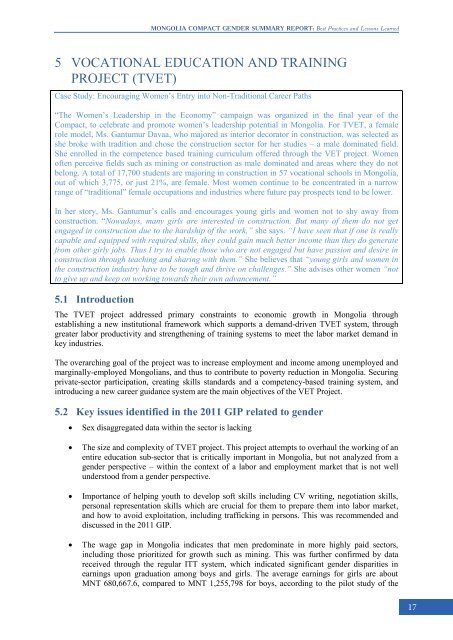Ulaanbaatar 2013
Ulaanbaatar 2013
Ulaanbaatar 2013
You also want an ePaper? Increase the reach of your titles
YUMPU automatically turns print PDFs into web optimized ePapers that Google loves.
Mongolia Compact Gender Summary Report: Best Practices And Lessons Learned5 VOCATIONAL EDUCATION AND TRAININGPROJECT (TVET)Case Study: Encouraging Women‟s Entry into Non-Traditional Career Paths“The Women‟s Leadership in the Economy” campaign was organized in the final year of theCompact, to celebrate and promote women‟s leadership potential in Mongolia. For TVET, a femalerole model, Ms. Gantumur Davaa, who majored as interior decorator in construction, was selected asshe broke with tradition and chose the construction sector for her studies – a male dominated field.She enrolled in the competence based training curriculum offered through the VET project. Womenoften perceive fields such as mining or construction as male dominated and areas where they do notbelong. A total of 17,700 students are majoring in construction in 57 vocational schools in Mongolia,out of which 3,775, or just 21%, are female. Most women continue to be concentrated in a narrowrange of “traditional” female occupations and industries where future pay prospects tend to be lower.In her story, Ms. Gantumur‟s calls and encourages young girls and women not to shy away fromconstruction. “Nowadays, many girls are interested in construction. But many of them do not getengaged in construction due to the hardship of the work,” she says. “I have seen that if one is reallycapable and equipped with required skills, they could gain much better income than they do generatefrom other girly jobs. Thus I try to enable those who are not engaged but have passion and desire inconstruction through teaching and sharing with them.” She believes that “young girls and women inthe construction industry have to be tough and thrive on challenges.” She advises other women “notto give up and keep on working towards their own advancement.”5.1 IntroductionThe TVET project addressed primary constraints to economic growth in Mongolia throughestablishing a new institutional framework which supports a demand-driven TVET system, throughgreater labor productivity and strengthening of training systems to meet the labor market demand inkey industries.The overarching goal of the project was to increase employment and income among unemployed andmarginally-employed Mongolians, and thus to contribute to poverty reduction in Mongolia. Securingprivate-sector participation, creating skills standards and a competency-based training system, andintroducing a new career guidance system are the main objectives of the VET Project.5.2 Key issues identified in the 2011 GIP related to genderSex disaggregated data within the sector is lackingThe size and complexity of TVET project. This project attempts to overhaul the working of anentire education sub-sector that is critically important in Mongolia, but not analyzed from agender perspective – within the context of a labor and employment market that is not wellunderstood from a gender perspective.Importance of helping youth to develop soft skills including CV writing, negotiation skills,personal representation skills which are crucial for them to prepare them into labor market,and how to avoid exploitation, including trafficking in persons. This was recommended anddiscussed in the 2011 GIP.The wage gap in Mongolia indicates that men predominate in more highly paid sectors,including those prioritized for growth such as mining. This was further confirmed by datareceived through the regular ITT system, which indicated significant gender disparities inearnings upon graduation among boys and girls. The average earnings for girls are aboutMNT 680,667.6, compared to MNT 1,255,798 for boys, according to the pilot study of thePage 17 of 8017


